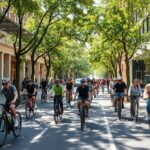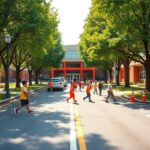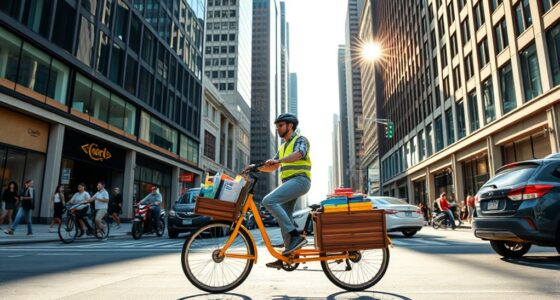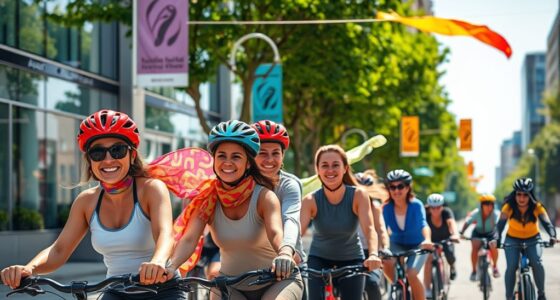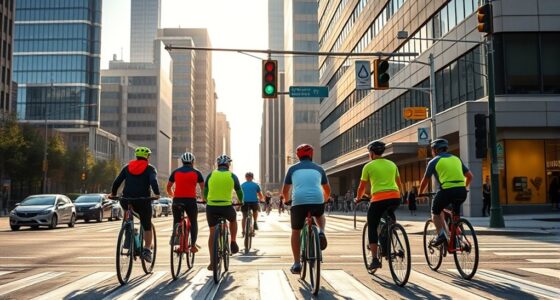Ciclovía open streets teach you that thoughtful urban planning, community involvement, and infrastructure upgrades are key to turning temporary street closures into lasting benefits. When you prioritize pedestrians and cyclists, you create safer, more accessible environments that encourage active lifestyles and social connections. Engaging residents early helps build pride and support, making these events more successful and sustainable. If you want to discover how to transform street spaces for your community, keep exploring these inspiring lessons.
Key Takeaways
- Engage communities early through outreach to ensure event design reflects local needs and fosters ownership.
- Prioritize infrastructure improvements like expanded bike lanes and widened sidewalks for lasting urban benefits.
- Incorporate psychological insights to create inclusive, welcoming environments that encourage active participation.
- Use strategic planning to transform temporary street closures into long-term enhancements for urban mobility.
- Leverage successful Ciclovía events as models to promote sustainable, active, and connected neighborhoods.

Have you ever experienced the joy of closing city streets to cars and opening them up to pedestrians and cyclists? This simple yet powerful act encapsulates the essence of a Ciclovía open streets event, transforming urban spaces into vibrant hubs of activity. When you participate or observe these events, you quickly realize how essential thoughtful urban planning is to their success. Cities that carefully design their streets to accommodate pedestrians and cyclists foster greater community engagement, making these events more than just temporary closures—they become opportunities for residents to connect, exercise, and enjoy their environment. Urban planning isn’t just about roads and buildings; it’s about creating inclusive spaces where everyone feels welcome and safe to move freely. By prioritizing pedestrian zones and cycling paths, cities can turn a routine street closure into a lasting benefit for public health and social cohesion. Additionally, incorporating elements based on psychological research can enhance the experience and encourage lasting behavioral changes toward active transportation. Community engagement plays a pivotal role in the success of Ciclovía events. When residents are involved in the planning process, they feel a sense of ownership and pride in their streets. This participation can take many forms—public meetings, surveys, or even volunteer efforts during the event. The more you get residents involved early on, the better the event will reflect local needs and preferences. It’s about fostering a shared understanding that these streets are for everyone, not just for cars. When community members see their input valued, they’re more likely to embrace the event, promote it to neighbors, and participate actively. This sense of collective ownership transforms a temporary street closure into a community-building experience that can inspire ongoing efforts to improve urban spaces. Furthermore, the lessons from successful Ciclovía open streets highlight the importance of integrating urban planning with community engagement. These events show that well-designed streets, paired with active participation from residents, can lead to safer, more accessible, and lively neighborhoods. It’s about thinking beyond just closing streets for a day—considering long-term infrastructure improvements, such as expanded bike lanes, widened sidewalks, and better signage. When cities combine strategic planning with grassroots involvement, they create a blueprint for sustainable urban mobility and social interaction. Ultimately, your city’s ability to host meaningful open streets events hinges on this balance—listening to community voices while carefully planning the physical space to support diverse, active lifestyles. That way, Ciclovía isn’t just a one-day event; it becomes a lasting catalyst for better urban living.
Frequently Asked Questions
How Do Ciclovía Events Impact Local Businesses?
You’ll find that ciclovía events boost local business by attracting more visitors to the area. This increased foot traffic creates a positive economic impact, as people are more likely to shop, dine, and explore nearby shops. As a result, your local businesses can see higher sales and greater community engagement, making these events a valuable opportunity for economic growth and strengthening local economies.
What Safety Measures Are Implemented During Open Streets?
During open streets, you see traffic safety measures like barriers, cones, and clear signage to protect participants. Crowd management is also a priority, with designated entry and exit points, volunteers guiding attendees, and controlled access to guarantee safety. These strategies help prevent accidents, manage large crowds effectively, and create a safe environment for everyone, allowing you to enjoy the event without concerns about traffic or crowd-related issues.
How Are Community Volunteers Involved in Ciclovía Events?
Imagine the buzz of community engagement as volunteers coordinate smoothly, guiding bikers and pedestrians alike. You see them smiling, handing out maps, and ensuring safety. Volunteers are essential, working behind the scenes to manage street closures and support participants. Their involvement creates a welcoming atmosphere, fostering local pride and participation. Through volunteer coordination, you help build a sense of community, making each open street event memorable and safe for everyone involved.
What Are the Environmental Benefits of Open Streets?
By participating in open streets, you help improve air quality and support urban wildlife. Reduced vehicle traffic means fewer emissions, which benefits your community’s air quality and creates a healthier environment. With less noise and pollution, urban wildlife like birds and insects thrive. Your involvement promotes sustainable urban living, making the streets safer and greener for everyone. So, every time you join, you contribute directly to a more environmentally friendly city.
How Can Cities Replicate Successful Ciclovía Models?
Imagine transforming streets into vibrant arteries of community life—that’s how you replicate successful ciclovía models. You should focus on integrating innovative urban planning that prioritizes pedestrian and cyclist needs. Engage the public early and often, making them stakeholders in the process. By fostering strong public engagement and thoughtful urban planning, cities can create open streets that thrive, encouraging active lifestyles and strengthening community bonds every time.
Conclusion
As you experience Ciclovía Open Streets, remember it’s like turning a busy highway into a community’s heartbeat. One Sunday, I saw kids racing bikes, neighbors chatting, and streets alive with joy—proof that open spaces foster connection. Data shows cities with open streets see a 20% drop in pollution and a boost in local businesses. Embrace these lessons: your streets can transform from thoroughfares to vibrant, shared spaces that bring everyone closer.



